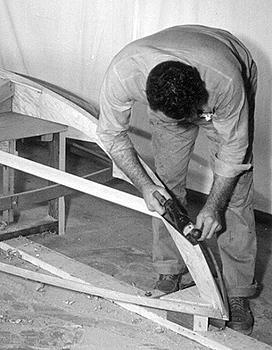Chine
Continued...

After the chine is fitted, pre-drill screw holes for the stem ending, coat all mating surfaces with glue, preferably epoxy. Have a helper hold the chine obliquely away from the boat and position the chine at the stem with a single screw. Use a clamp, rope, Spanish windlass, or braces to hold the chine against the stem if the screw junction is not adequate. Spring the chine around the boat, and when in place, drive a second (or more) screw through the chine into the stem then progressively fasten into the frames. Often, screws holding the chines into the forward frames are omitted at this stage, and the member clamped in place or a finishing nail in a pre-drilled hole or a thin drywall screw. If a large countersunk hole is drilled for a screw, at the point of severe bending, the chine will probably break. After the glue has set and the boat is planked, the screw fastening can be installed. Keep bending the chine after fastening into the frames. Most prefer to leave the chine extending past the transom, trimming to fit, when most of the fasteners are holding the chine to the frames.

We haven't had to steam chines in place on any of the GLEN-L prototypes. However, we choose the lumber with care and have a big stock to select from. If the member seems difficult to bend, the chine can be forced in place as far as possible. Wrap the area of greatest stress with old towels, pour boiling hot water over the area, and immediately bend in place as far as practical. The process can be repeated several times if necessary; bending the chine progressively forcing it in place. When released, the chine will retain a partial set but can be re-bent in place easier.

Most who have trouble bending in the chine have not thought through the process. And of course as described above, you can usually fix a goof with shims. But, that should not be necessary. Use a short length of the chine to see how it fits against the stem. Use scraps of plywood to simulate how the bottom and sides must mate to the stem and chine. If you fully understand how the chine mates at the stem and frames and how the side and bottom must lay flat against the member, the actual process becomes easier. In other words, THINK before you start fitting the chine in place.
Chine drawings.